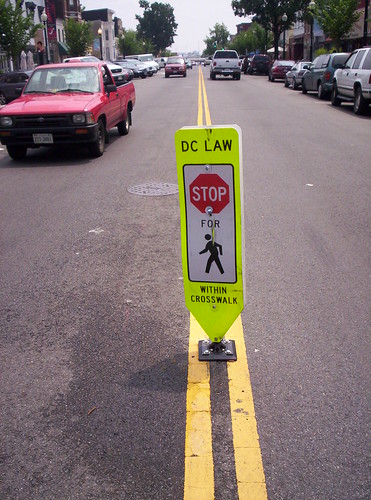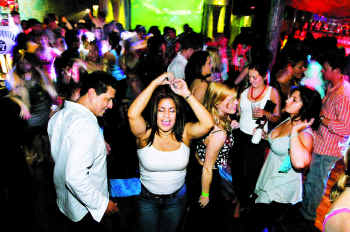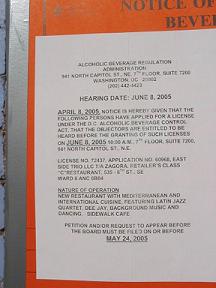The Future of Barracks Row? A Counter-point to letter to the editor about Smoke-Free Restaurants
In yesterday's Post, Elliot Wright, manager of Finn MacCool's on 8th Street SE (Barracks Row) writes in "Smoke-Free vs. Free to Smoke":
I am the general manager of Finn MacCool's Irish Pub on Eighth Street SE. My customers primarily are professionals and families who live and work in the neighborhood. The pub has two dining areas and bars, each with its own heating, ventilation and air conditioning system.
Most of my floor and kitchen staff are worried that their livelihoods will be damaged by a smoking ban [news story, June 19]. Customers who smoke spend more time and more money than those who do not. Often I have difficulty staffing the nonsmoking section of the restaurant for that reason.
My servers, bartenders, food runners and busboys and girls have chosen to work in a restaurant that allows smoking because they feel it is in their best interest financially or because smoke does not bother them. Less than a block away is a restaurant that is smoke-free. Just like customers, restaurant workers have the freedom to choose.
I don't deny the negative health effects of smoke -- the scientific evidence is overwhelming -- and I am concerned about the health of my employees. However, I am also concerned with their happiness, which is tied to a positive work environment and a busy restaurant.
Smoking is not a crime -- it is a regulated activity, just like the consumption of alcohol. It is the duty of the D.C. Council to regulate smoking in a reasonable manner, but that should take the form of legislation that respects the wishes of customers, restaurant workers and owners.
___________________
Elliot Wright has a limited perspective and clearly doesn't understand the restaurant business as well as he should...
The late founder of Clyde's, Stuart Davidson, had a great quote that sums up why the Clyde's Restaurant Group is so successful:
It's more fun to eat in a saloon than it is to drink in a restaurant.
The fact is, restaurant sections by bars, smoking or not, are more popular than sections not by the bar.
Finn MacCool's upstairs is nice, but boring. It's not connected to the street, it's not by the bar. I guarantee that if they switched things around, and made the first floor non-smoking, it would still be the most popular area of the restaurant.
 Barracks Row at E and 8th Streets SE.
Barracks Row at E and 8th Streets SE.Marty's Restaurant, one block away from Finn MacCool's is a 100% non-smoking restaurant in the interior (people can smoke during temperate weather outside). It's busier than Finn MacCools, but the sections by the bar are busier regardless. Marty's does lose some customers that prefer to smoke. On the other hand, it attracts a fair amount of family business, which likely compensates for it.
Plus, as a waiter, I appreciate not having to breathe smoke, or have my hair or clothes reek of it. The fact is that smoking not only smells but the possible health effects from second-hand exposure are real. At times I make less money at Marty's than I would in a Dupont Circle or Georgetown location, but the fact that the restaurant is smoke free is one reason I put up with it.
I know that people who drink spend more money, but I think that research demonstrating a positive link between smoking and drinking and tipping, especially "extra-normal" tipping is not solid. From my own experience waiting on about 100,000 tables over the years, I say that:
(1) People who drink have higher checks.
(2) Generally (but not always) this results in higher tips only from a gross standpoint because after all a higher check means that a 15% to 20% tip is going to naturally be higher based on a $6 glass of wine, versus a $2 Coke or a free glass of water.
(3) Because smoking behavior is associated with class (socioeconomic status), in my experience I often find that drinking smokers are bad tippers, especially if they smoke heavily. This makes sense, because research into tipping behavior by economists and sociologists finds that a willingness to tip is based on SES, and people of lower SES are less inclined to tip in general, as well as to tip at the commonly accepted percentage of 15% to 20%.
(4) Smoking behavior is also associated with youth, and younger people, perhaps for similar SES reasons, tend to not be great tippers.
Anyway, for the long-term success of his restaurant, I suggest that Mr. Wright focus on some other issues:
(1) Each new restaurant that opens on Barracks Row reduces the revenue of the extant restaurants.
(2) The population density of the immediate area is not enough to support all the restaurants that are open currently
(3) Unless the district is able to attract other market segments from outside of the greater Capitol Hill neighborhood.
(4) At the present, only a few restaurants on the street are distinctive enough to draw from outside of the immediate neighborhood and whether or not they do is questionable.
 (5) Even though I am against public funding of a new baseball stadium there is no question that the inaugural season of the Washington Nationals has increased the business of restaurant-tavern establishments on Barracks Row, and this is likely to continue even when the new stadium is built, because it will be a long time before that immediate area develops a variety of restaurant and other entertainment destinations. (In fact, I tremble to think about how bad the money would be overall on Barracks Row right now without any baseball-related business.)
(5) Even though I am against public funding of a new baseball stadium there is no question that the inaugural season of the Washington Nationals has increased the business of restaurant-tavern establishments on Barracks Row, and this is likely to continue even when the new stadium is built, because it will be a long time before that immediate area develops a variety of restaurant and other entertainment destinations. (In fact, I tremble to think about how bad the money would be overall on Barracks Row right now without any baseball-related business.)(6) This should reinforce the understanding that Barracks Row needs other attractions in order to draw customers particularly at night. Restaurants aren't enough.
(7) This is why I think it is short-sighted for the Barracks Row Main Street program and other civic groups to oppose attempts to bring more entertainment options to the street. There is a way to balance providing new attractions without becoming a nightclub district. Especially because Capitol Hill is far away from where most of the people more inclined to go out on a Thursday or Friday or Saturday night live.
It's likely to not have to fear becoming a serious "destination district" on the scale of a Georgetown, Clarendon, Shirlington, or Adams-Morgan -- but us poor waiters need something more to have more customers to wait on, especially on a Saturday night, when people are likely to go to a district where they can do something after they eat other than hanging out in front of the 7-11.
 Fear of an Adams-Morgan Like Future; A Real Concern or Merely Fantasy?
Fear of an Adams-Morgan Like Future; A Real Concern or Merely Fantasy?For some Barracks Row restaurant reviews, including Marty's, see this article from the Weekend Section of the Post: "Comfortable Spots on Barracks Row".
 ABC Hearing notice for application of a licensed establishment at the People's Church, 500 block of 8th Street SE. Photo by Norman Metzger, via DCist.
ABC Hearing notice for application of a licensed establishment at the People's Church, 500 block of 8th Street SE. Photo by Norman Metzger, via DCist.For a discussion of the issue of Barracks Row and its future, particularly with regard to the reuse of the People's Church, see this post from DCist.
Finally, getting back to smoking in restaurants, the experience in New York City has proven that the fears of a big falloff of business are overblown (see http://www.americanheart.org/presenter.jhtml?identifier=3016321 or do a google search of your own). Marty's survives... and I probably make more money than the average waiter at Finn MacCool's.



0 Comments:
Post a Comment
<< Home